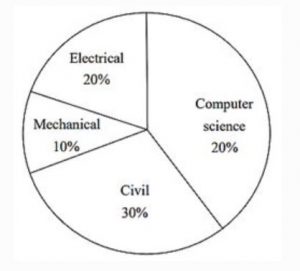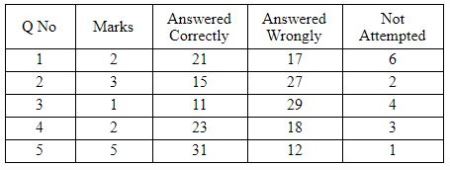GATE 2015 [Set-1]
Question 1 |
Didn’t you buy _________ when you went shopping?
any paper | |
much paper | |
no paper | |
a few paper |
Question 2 |
Which of the following combinations is incorrect?
Acquiescence – Submission | |
Wheedle – Roundabout | |
Flippancy – Lightness | |
Profligate – Extravagant |
Wheedle = Use endearments (or) flattery to persuade some to do something
Flippancy = Lack of respect (or) seriousness
Profligate = Recklessly extravagant
Question 3 |
Given set A = {2, 3, 4, 5} and Set B = {11, 12, 13, 14, 15}, two numbers are randomly selected, one from each set. What is probability that the sum of the two numbers equals 16?
0.20 | |
0.25 | |
0.30 | |
0.33 |
Total outcomes = 4C1 × 5C1 = 20
Probability = Favourable outcomes/ Total outcomes = 4/20 = 0.20
Question 4 |
Which of the following options is the closest in meaning to the sentence below?
She enjoyed herself immensely at the party.
She had a terrible time at the party. | |
She had a horrible time at the party. | |
She had a terrific time at the party. | |
She had a terrifying time at the party. |
→ Horrible and terrible means fearful.
→ Terrific = Wonderful
→ So, C is the Answer.
Question 5 |
Based on the given statements, select the most appropriate option to solve the given question.
If two floors in a certain building are 9 feet apart, how many steps are there in a set of stairs that extends from the first floor to the second floor of the building?
Statements:-
(I) Each step is 3/4 foot high.
(II) Each step is 1 foot wide.
Statement I alone is sufficient, but statement II alone is not sufficient. | |
Statement II alone is sufficient, but statement I alone is not sufficient.
| |
Both statements together are sufficient, but neither statement alone is sufficient. | |
Statement I and II together are not sufficient. |
Statement I:
Each step is 3/4 foot high.
No. of steps = 9/(3/4) = 12 steps
Statement I alone is sufficient.
Statement II:
Each step is 1 foot wide.
Statement II alone is not sufficient.
Question 6 |
The pie chart below has the breakup of the number of students from different departments in an engineering college for the year 2012. The proportion of male to female students in each department is 5:4. There are 40 males in Electrical Engineering. What is the difference between numbers of female students in the Civil department and the female students in the Mechanical department?

32 | |
33 | |
34 | |
35 |
There are 40 males in Electrical Engineering.
⇒ Number of females in Electrical Engineering = 4/5 × 40 = 32
Total number of students in Electrical Engineering = 40+32 = 72
This constitutes 20% of the strength of college.
Number of students in Civil department = 30/100 × 72 = 108
Number of female students in Civil department = 4/(4+5) × 108 = 48
Number of students in Mechanical department = 10/20 × 72 = 36
Number of female students in Mechanical department = 4/(4+5) × 36 = 16
Required Difference = 48 - 16 = 32
Question 7 |
Select the alternative meaning of the underlined part of the sentence.
The chain snatchers took to their heels when the police party arrived.
took shelter in a thick jungle | |
open indiscriminate fire | |
took to flight | |
unconditionally surrendered |
Question 8 |
The probabilities that a student passes in Mathematics, Physics and Chemistry are m, p and c respectively. Of these subjects, the student has 75% chance of passing in at least one, a 50% chance of passing in at least two and a 40% chance of passing in exactly two. Following relations are drawn in m, p, c:
-
(I) p + m + c = 27/20
(II) p + m + c = 13/20
(III) (p) × (m) × (c) = 1/10
Only relation I is true | |
Only relation II is true | |
Relations II and III are true. | |
Relations I and III are true. |
= 1 - (1 - m) (1 - p) (1 - c) = 0.75 ----(i)
50% of students have a chance pass in atleast two
(1 - m)pc + (1 - p)mc + (1 - c) mp + mpc = 0.5 ----(ii)
40% of students have a chance of passing exactly two
(1 - m)pc + (1 - p)mc + (1 - c)mp = 0.4 ----(iii)
From equation (ii) and (iii) we can get
mpc = 0.1
⇒ m*p*c = 1/10
Statement (III) is correct.
→ Simplify eq (i), we get
⇒ p+c+m - (mp+mc+pc) + mpc = 0.75
⇒ p+c+m - (mp+mc+pc) = 0.65 ----(iv) → Simplify equation (iii), we get
⇒ pc + mc + mp - 3mpc = 0.4
From (iv) and (v)
p + c + m - 0.7 = 0.65
⇒ p + c + m = 1.35 = 27/20
Statement (I) is correct.
Question 9 |
The given statement is followed by some courses of action. Assuming the statement to be true, decide the correct option.
Statement:
There has been a significant drop in the water level in the lakes supplying water to the city.
Course of action:
-
(I) The water supply authority should impose a partial cut in supply to tackle the situation.
(II) The government should appeal to all the residents through mass media for minimal use of water.
(III)The government should ban the water supply in lower areas.
Statements I and II follow | |
Statements I and III follow | |
Statements II and III follow | |
All statements follow |
Banning of water in lower areas is not the solution of the problem.
Question 10 |
The number of students in a class who have answered correctly, wrongly, or not attempted each question in an exam, are listed in the table below. The marks for each question are also listed. There is no negative or partial marking.

What is the average of the marks obtained by the class in the examination?
2.290 | |
2.970 | |
6.795 | |
8.795 |
Total marks obtained = 21 × 2 + 15 × 3 + 11 × 1 + 23 × 2 + 31 × 5 = 299
Average marks = 299/44 = 6.795
Question 11 |
Which one of the following is True at any valid state in shift-reduce parsing?
Viable prefixes appear only at the bottom of the stack and not inside | |
Viable prefixes appear only at the top of the stack and not inside | |
The stack contains only a set of viable prefixes | |
The stack never contains viable prefixes |
A viable prefixes is prefix of the handle and so can never extend to the right of handle, i.e., top of stack.
So set of viable prefixes is in stack.
Question 12 |
Match the following:
(P) Condition coverage (i) Black-box testing (Q) Equivalence class partitioning (ii) System testing (R) Volume testing (iii) White-box testing (S) Alpha testing (iv) Performance testing
P-ii, Q-iii, R-i, S-iv | |
P-iii, Q-iv, R-ii, S-i | |
P-iii, Q-i, R-iv, S-ii | |
P-iii, Q-i, R-ii, S-iv |
Equivalence class partitioning ⇒ is a software testing technique that divides the input data of a software unit into partitions of equivalent data from which test cases can be derived, which is nothing but black box testing. Hence B-1.
Volume testing ⇒ Performance testing - C-4.
Alpha testing ⇒ System Testing D-2.
Question 13 |
For computers based on three-address instruction formats, each address field can be used to specify which of the following:
-
(S1) A memory operand
(S2) A processor register
(S3) An implied accumulator register
Either S1 or S2 | |
Either S2 or S3 | |
Only S2 and S3 | |
All of S1, S2 and S3 |
So as the question asks what can be specified using the address fields, implied accumulator register can't be represented in address field.
So, S3 is wrong.
Hence Option A is the correct answer.
Question 14 |
Which one of the following is the recurrence equation for the worst case time complexity of the Quicksort algorithm for sorting n(≥ 2) numbers? In the recurrence equations given in the options below, c is a constant.
T(n) = 2T(n/2) + cn | |
T(n) = T(n – 1) + T(1) + cn | |
T(n) = 2T(n – 1) + cn | |
T(n) = T(n/2) + cn
|
Hence recurrence relation T(n) = T(n - 1) + T(1) + cn.
Question 15 |
For any two languages L1 and L2 such that L1 is context-free and L2 is recursively enumerable but not recursive, which of the following is/are necessarily true?

I only | |
III only | |
III and IV only | |
I and IV only |
 is recursive,
is recursive,This one is true, because L1 is context free which is nothing but recursive, recursive language is closed under complement hence true.
2 ⇒
 (complement of L2) is recursive
(complement of L2) is recursiveIf L2 and
 both are recursive enumerable then
both are recursive enumerable then  is recursive.
is recursive. Hence option 2 is false
3 ⇒
 is context free
is context freeWhich is false because context free language does not closed under complement
4 ⇒
 ∪L2 is recursive enumerable
∪L2 is recursive enumerable  ⇒ recursive
⇒ recursiveEvery recursive language is also recursive enumerable
L2 ⇒ recursive enumerable
 ∪ L2 ⇒ recursive enumerable
∪ L2 ⇒ recursive enumerableBecause recursive enumerable language closed under union.
Question 16 |
Suppose two hosts use a TCP connection to transfer a large file. Which of the following statements is/are False with respect to the TCP connection?
- 1. If the sequence number of a segment is m, then the sequence
number of the subsequent segment is always m+1.
2. If the estimated round trip time at any given point of time is t sec, the value of the retransmission timeout is always set to greater than or equal to t sec.
3. The size of the advertised window never changes during the course of the TCP connection.
4. The number of unacknowledged bytes at the sender is always less than or equal to the advertised window.
III only | |
I and III only | |
I and IV only | |
II and IV only |
If the sequence no. of the segment is m, then the sequence number of the subsequent segment depends on the current segment size.
II. True.
If the estimated RTT at any given point of time is t second, then the value of the re-transmission timeout is always set to greater than or equal to t sec.
III. False.
The size of the advertised window may change during the course of the TCP connection depending on the processing capability at the receiver's side and the network traffic.
IV. True.
The number of unacknowledged bytes at the sender is always less than or equal to the advertised window, because the sender never sends no. of bytes greater than advertised window.
![GATE 2015 [Set-1]](https://solutionsadda.in/wp-content/uploads/2019/05/green-new-logo.png)